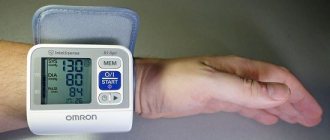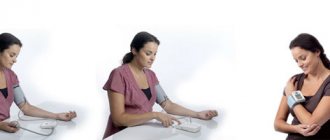An electrocardiogram is the most important diagnostic technique that allows you to assess the functioning of the heart, as well as timely diagnose cardiac diseases. The key to reliable and comprehensive information is strict adherence to the algorithm for performing the procedure. This includes, first of all, the normal functioning of the device itself, the technique of placing electrodes, as well as the features of their application.
An electrocardiographic study records the electrical fields arising during the life of the heart on paper or a display, it depends on the type of device, a record is issued.
With the help of an ECG, the doctor can determine the further type of adequate therapy
There are three main components of an electrocardiograph:
- input devices, which include the electrodes themselves and the cable;
- amplifiers;
- sensor.
ECG recording algorithm
For correct diagnosis, making an accurate diagnosis and prescribing optimal treatment, it is important to adhere to the following algorithm of actions, namely:
- preparing the patient for the procedure;
- checking the operation of the device;
- application of electrical transmission gels and antiseptic liquids;
- adherence to clear rules on where to place electrodes depending on color;
- selection of lead registration scheme;
- directly recording.
In most cases, the electrocardiogram is recorded in a separate room in a medical facility, but sometimes it can even occur at home, in a ward, or in an ambulance. The room in which the procedure will be performed must be at a sufficient distance from possible electrical interference. As for the couch itself, on which the patient lies, it is located approximately two meters from the power supply.
An ECG is an absolutely painless procedure that does not cause absolutely any negative emotions
The procedure is carried out in a lying position, with free access to the upper torso, legs and arms. If there are contraindications, then an ECG can be performed in a sitting position. Before an electrocardiogram, it is better not to engage in intense physical activity, and also not to take food or drinks that could activate the heart.
How to prepare for the procedure, how it is carried out, who does the decoding
Electrocardiography does not require special preparation. The patient can undergo examination at any time. Before visiting the functional diagnostics office, you need to take care of your appearance, since you will have to expose your chest, forearms and shins, to which the electrodes are attached.
Important! Before the examination, it is not recommended to overeat, smoke, worry, go to the gym or run, drink alcohol, coffee, or energy drinks.
Taking an ECG looks like this: the patient removes the necessary areas of the body from clothing and lies down on the couch. The doctor or nurse degreases the skin with a special product (or water) so that the “suction cups” have better contact with the body, applies electrodes, turns on the device and makes a recording. With the results obtained and a preliminary transcript, the patient is sent to the attending physician.
Rules for applying electrodes for ECG
I would like to immediately note that the electrodes for the ECG are located in different places. What is this connected with? This is the only way to catch all the heart impulses. There may be disturbances in heart rate and rhythm in different places.
The electrode application scheme includes the following:
- degreasing the skin with alcohol;
- abundant hair is treated with a soap solution;
- if the electrodes are disposable, then for high-quality recording of heart impulses it is necessary to remove the hair;
- Although some people use gauze, it is better to use conductive paste. As a last resort, you need to take saline solution.
ECG electrodes can be disposable or reusable
I would like to make a special mention regarding disposable electrodes. They are not included in all kits; most likely, they can be found in the latest brands of the device. According to experts, such electrodes are simple and easy to use, and also help reduce the preparation period for the patient before the procedure. They are usually used by private clinics. They are made of foil, which reduces the likelihood of disease transmission. In addition, disposable electrodes improve contact due to better conductivity. They are often used in cases where a cardiogram needs to be taken quickly, as well as for hyperhidrosis.
If we are talking about reusable electrodes, then we cannot fail to note their durability; of course, they are stronger. They are produced in the form of suction cups and clothespins. The signal passage is a little difficult, unlike the above mentioned electrodes for reusable use of a rougher design.
Stages of the ECG procedure
Electrocardiography is a research method in which the electrical fields of the heart are recorded, provoked by contractions of the heart muscle. As a result, the specialist receives a cardiogram - an image of curve graphs. They can be displayed on a monitor or recorded on a special paper tape. To carry out this type of diagnosis, you need professional medical equipment - a cardiograph. This device consists of three required elements.
- An input device including electrodes, lead cables and their switches.
- Signal amplifier - allows you to amplify them to the value necessary for analysis.
- Recording unit for direct recording of a cardiogram.
When conducting an ECG, a specialist works sequentially with all these blocks, following a clear algorithm. It, in turn, is divided into several stages:
- preparing the room, equipment and patient for ECG;
- application of electrodes and connection of leads according to a specific scheme;
- adjusting the gain to correctly display the signal on the cardiogram;
- direct recording of the electrocardiogram.
For informative and reliable research results, it is necessary to avoid errors at each of these stages. Therefore, let’s take a closer look at their algorithms and features.
Electrode locations
Devices must be applied to the following areas of the body:
- lower limbs: right and left leg (black and green electrode, respectively);
- upper limbs. Red on the right hand, yellow on the left;
- rib cage.
Chest electrodes are installed according to the following scheme:
- 1 lead. On the right side at the level of the fourth intercostal space;
- 2 lead. On the left side – the fourth intercostal space;
- 3 lead. Between the first and second;
- 4 lead. Fifth intercostal space on the left side;
- 5 lead. The same line goes, only along the anterior premuscular region;
- 6 lead. Corresponds to the left premuscular zone.
Despite the fact that an electrocardiogram seems to be a simple manipulation, to obtain correct results it is important to adhere to medical recommendations
In order to obtain reliable information about the functioning of the heart, you must adhere to the following recommendations:
- the day before you should have a good rest both physically and emotionally;
- Before the procedure, a light breakfast is allowed a maximum of two hours;
- strong coffee and tea, alcohol, smoking, energy drinks - all this is prohibited on the day of the study;
- if possible, it is necessary to reduce the amount of hygiene products, because they impair conductivity due to the formation of a fatty film;
- the room in which the study is carried out must be warm, the patient must be comfortable, but if physiological tremors are present, this will certainly affect the results.
Carrying out an ECG according to Slopak
The methodology is not very different from standard research. In this case, not six, but nine chest leads are used. The first six leads are also attached, and the next ones are presented below:
- 7 lead. Fifth hypochondrium, axillary region;
- 8 lead. Scapular line at the same level;
- 9 lead. Paravertebral line.
Electrocardiogram according to Slopak allows you to get a more detailed picture of the heart’s work
ECG by Sky
This type of research also differs from the standard technique in the placement of electrodes. The bottom line is that electrodes are placed on the chest area in three places, namely:
- 1 red lead is placed on the right side at the level of the second intercostal space;
- 2 yellow lead is installed on the left at the same level only along the posterior axillary line;
- Green lead 3 is the midclavicular line on the left side of the sternum.
As a result, a kind of triangle is created, the corners of which will serve as projection sites for the leads of the electrical activity of the heart. As for the indications, this technique is carried out in case of suspected heart attack, as well as for athletes during sports.
To increase the information content of the method, medication and stress tests are carried out. To identify areas of hidden ischemia, the test may be done after physical activity, such as squats, or after taking certain medications.
Sky leads will help identify coronary heart disease
Long registration
Data on the electrical work of the heart can be recorded over several hours or even days. Why is this necessary? Thus, doctors can identify transient disturbances in heart rhythm, and also compare the identified deviations with the patient’s activity during the day and his complaints of pain.
Let's consider the indications for long-term monitoring:
- complaints from patients about interruptions in the functioning of the heart, as well as a sensation of short-term palpitations, the interpretation of which is difficult on a conventional electrocardiograph;
- complaints in which angina pectoris can neither be excluded nor confirmed;
- the occurrence of attacks of weakness, fainting, dizziness, the cause of which has not been established;
- monitoring the functioning of an artificial heart pacemaker;
- IHD, as a control and identification of a type of arrhythmia that is asymptomatic;
- as a monitoring of the effectiveness of drugs and to identify undesirable effects on cardiac activity.
Our doctors
Kedrinskaya Larisa Ivanovna
Experience 18 years / Doctor of the highest category, Candidate of Medical Sciences / General practitioner, cardiologist
Çà ïèñà òüñÿ ê âðà ÷ó
Vershuta Elena Vasilievna
More than 23 years of experience / Highest category, Candidate of Medical Sciences / Pediatric cardiologist, cardiologist, therapist
Çà ïèñà òüñÿ ê âðà ÷ó
+
Where to put children's electrodes?
An ECG of the heart helps to identify such pathological processes in children: defects, myocardial infarction, angina pectoris, etc. The study is easy to conduct and accessible. The manipulation can be carried out before planned surgical interventions, when heart murmurs are detected, before entering a sports section or school.
During the procedure, the child must behave calmly, so it is necessary to prepare him and explain that installation of the sensors is absolutely painless
The specialist installs nine to twelve electrodes on the child’s body: in the ankles, wrists and on the chest. Sensors of smaller sizes and special shapes are used, since children have more delicate skin. It is best to use electrodes for one-time use.
So, an electrocardiogram is an informative diagnostic method used for both adults and children. The procedure is simple, accessible, and does not cause any discomfort. An ECG will help identify serious cardiac disorders and determine the correct treatment. To obtain accurate results, it is important to adhere to the recommendations regarding preparation and the manipulation itself. Early diagnosis is the key to a speedy recovery!
How to undergo an ECG without problems, so that there are no difficulties in making a diagnosis?
POSITION
about the processing of personal data
This Regulation defines the policy, procedure and conditions of the Operator regarding the processing of personal data, establishes procedures aimed at preventing and identifying violations of the legislation of the Russian Federation, eliminating the consequences of such violations related to the processing of personal data. All issues related to the processing of personal data that are not regulated by these Regulations are resolved in accordance with current legislation
Russian Federation in the field of personal data.
1) directly personal data.
regarding the processing of personal data, with this Regulation and amendments to it. Training of these employees is organized by the structural unit for advanced training in accordance with schedules approved by the Operator.
subject to the prior consent of the subject of personal data. Consent may be oral or written.
The specified processing of personal data is considered to be carried out without the prior consent of the subject of personal data, unless the Operator proves that such consent has been obtained.
ensuring the protection of personal data processed by the Operator from unauthorized or accidental access to it, destruction, modification, blocking, copying, provision, distribution of personal data, as well as from other unlawful actions in relation to personal data;
exercise internal control over compliance by his subordinates with the requirements of the legislation of the Russian Federation in the field of personal data, including requirements for the protection of personal data;
bring to the attention of the Operator’s employees the provisions of the legislation of the Russian Federation in the field of personal data, local acts on the processing of personal data, requirements for the protection of personal data;
organize the reception and processing of requests and requests from personal data subjects or their representatives, as well as monitor the receipt and processing of such requests and requests;
in case of violation of the requirements for the protection of personal data, take the necessary measures to restore the violated rights of personal data subjects.
have access to information regarding the processing of personal data entrusted to him and including:
purposes of processing personal data;
categories of personal data processed;
categories of subjects whose personal data is processed; legal grounds for processing personal data;
a list of actions with personal data, a general description of the methods used by the Operator for processing personal data;
description of the measures provided for in Art. Art. 18.1 and 19 of the Federal Law of July 27, 2006 N 152-FZ “Personal Data”, including information on the availability of encryption (cryptographic) means and the names of these means;
date of commencement of processing of personal data;
term or conditions for termination of processing of personal data;
information about the presence or absence of cross-border transfer of personal data during their processing;
information on ensuring the security of personal data in accordance with the requirements for the protection of personal data established by the Government of the Russian Federation;
involve other employees of the Operator in the implementation of measures aimed at ensuring the security of personal data, assigning them the corresponding duties and assigning responsibility.
executive power, internal documents of the Operator, as well as the reasons and conditions that contributed to the commission of the violation.










